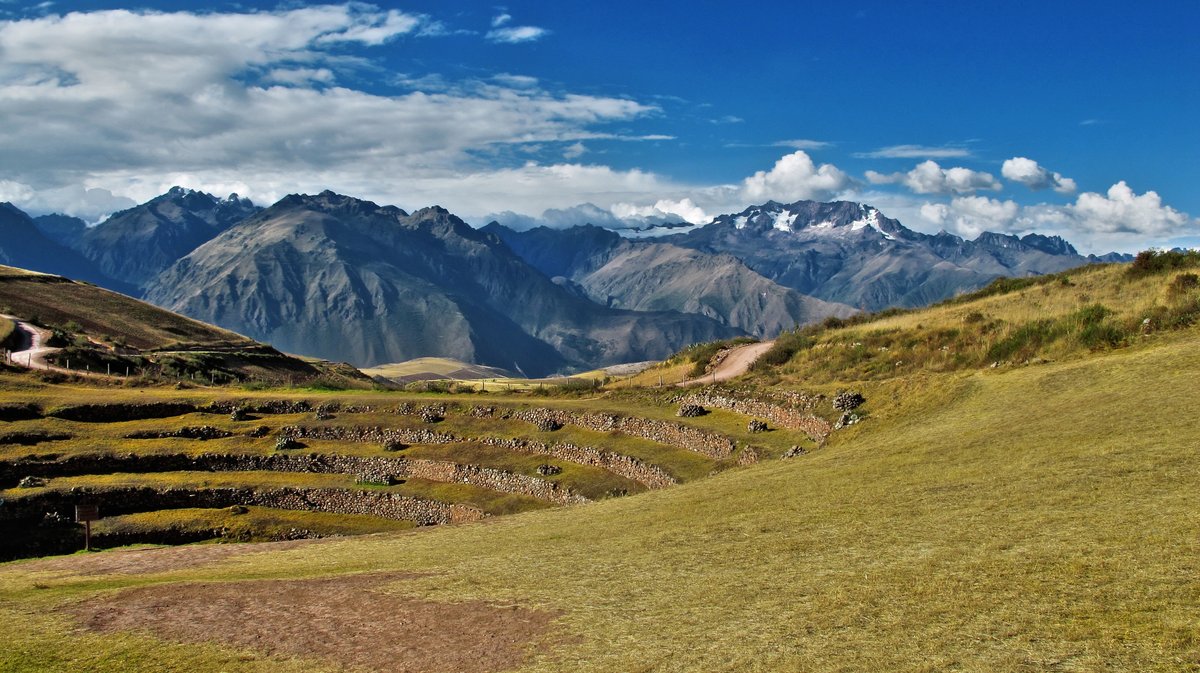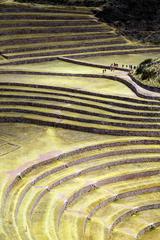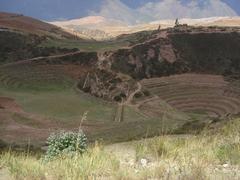
Moray and Maras Peru: Visiting Hours, Tickets, and Historical Sites Guide
Date: 14/06/2025
Introduction
Nestled in the heart of Peru’s Sacred Valley near Cusco, Moray and Maras stand as extraordinary testaments to Inca ingenuity and the enduring heritage of the Andean peoples. Moray’s enigmatic concentric terraces functioned as an advanced agricultural laboratory, demonstrating the Incas’ mastery of environmental management and their deep spiritual connection to the landscape (Inkayni Peru Tours; Come See Peru Tours). Just a short distance away, the Maras Salt Mines reveal ancient salt extraction techniques that predate the Inca Empire. Here, thousands of terraced salt pans, still harvested by local families, sustain both the local economy and ancestral traditions (Two Outliers; Kondor Path Tours).
This guide provides a comprehensive overview of Moray and Maras, including historical significance, visitor information, sustainable tourism practices, and practical travel tips to help you fully appreciate and respectfully explore these remarkable Sacred Valley sites.
Table of Contents
- Moray: Archaeological and Agricultural Innovation
- Maras: The Living Salt Mines
- Interconnected Heritage in the Sacred Valley
- Conservation and Responsible Tourism
- Contemporary Experiences
- Getting There: Transportation and Logistics
- FAQs
- Visuals
- Summary and Visitor Tips
Moray: Archaeological and Agricultural Innovation
Inca Agricultural Laboratory
Moray is one of the most intriguing archaeological sites in the Sacred Valley. Its circular terraces, descending amphitheater-style into the earth, were engineered to create about 20 microclimates, with temperature differences of up to 17°C (63°F) between the top and bottom levels (Inkayni Peru Tours). This allowed the Incas to experiment with cultivating a wide range of crops, adapting them to different environmental conditions and altitudes (Come See Peru Tours; Amusing Planet; Two Outliers).
The design showcases advanced knowledge of agriculture, irrigation, and environmental adaptation. The terraces were filled with fertile soil, and an intricate irrigation system delivered water from springs and glacial melt (Quechuas Expeditions).
Spiritual and Cultural Dimensions
Moray’s circular form is thought to symbolize the Andean concept of cyclical time and interconnectedness. Researchers also suggest ceremonial use, possibly tied to the worship of Pachamama (Mother Earth) and agricultural deities (Come See Peru Tours).
Visiting Hours and Tickets for Moray
- Hours: Daily, 7:00 AM to 5:00 PM (last entry around 4:30 PM).
- Tickets: Entry is included in the Boleto Turístico del Cusco (Cusco Tourist Ticket), costing approximately 70 soles. Tickets can be purchased at the site or in Cusco (Come See Peru Tours; Travel with Wes).
Accessibility and Travel Tips
Moray sits at about 3,500 meters (11,500 feet) elevation. Acclimatize for at least one day in Cusco, stay hydrated, and wear sturdy shoes for uneven terrain.
Maras: The Living Salt Mines
Ancient Salt Extraction Techniques
The Maras Salt Mines, or Salineras de Maras, consist of over 3,000 terraced salt pans fed by a subterranean mineral spring. This salt extraction method predates the Inca Empire and is still practiced by local families (Come See Peru Tours; Two Outliers).
Saline water is channeled into the pans, evaporating under the sun and leaving crystallized salt, which is harvested by hand. The pinkish hue of Maras salt is due to trace minerals (Inkayni Peru Tours).
Economic and Cultural Importance
Salt from Maras has long been a vital Andean commodity for preservation, trade, and ceremonial offerings. The communal management of the salt pans embodies the Andean principle of ayni (reciprocity), with families inheriting and maintaining individual pools (Come See Peru Tours).
Visiting Hours and Tickets for Maras
- Hours: Daily, 7:00 AM to 5:00 PM.
- Tickets: Entry costs approximately 10 soles, payable onsite. Not included in the Boleto Turístico (Travel with Wes).
Accessibility
The salt mines are accessible by vehicle, but involve walking on uneven and sometimes slippery terrain.
Interconnected Heritage in the Sacred Valley
Integration with Andean Traditions
Moray and Maras are woven into the Sacred Valley’s broader cultural tapestry. Quechua-speaking communities continue ancestral practices—agriculture, weaving, and communal festivals—nearby (Inkayni Peru Tours). Villages like Chinchero are renowned for textile traditions, offering visitors immersive cultural experiences.
Festivals and Rituals
Festivals such as Inti Raymi (Festival of the Sun) in June celebrate agricultural cycles and spiritual connections to the land (AB Expeditions).
Conservation and Responsible Tourism
Environmental Stewardship
Visitor fees directly support site maintenance, preservation, and waste management. Guides emphasize respect for marked paths and minimizing environmental impact (Inkayni Peru Tours). Support local artisans and producers for a positive economic impact.
Visitor Guidelines
- Acclimatize and use sun protection.
- Entrance to Moray requires the tourist ticket; Maras is a separate fee.
- Guided tours provide deeper insight (Come See Peru Tours).
Cultural Respect
Ask permission before photographing people and support local economies by purchasing handmade goods (Inkayni Peru Tours).
Contemporary Experiences
Culinary and Adventure Tourism
The acclaimed MIL restaurant near Moray, led by chef Virgilio Martínez, offers a tasting menu celebrating Andean ingredients (Come See Peru Tours). The area is also popular for mountain biking, horseback riding, and ATV tours.
Getting There: Transportation and Logistics
Moray and Maras are about 50 kilometers from Cusco. Travel options include:
- Tours: Many agencies in Cusco offer combined tours with transportation and guides.
- Public Transport: Colectivos to Urubamba, then taxi to Maras or Moray.
- Private Vehicle: Renting a car or hiring a driver offers flexibility (Travel with Wes).
Practical Tips for Visiting Moray and Maras
- Best Time to Visit: Dry season (May–September) for clear weather and photogenic salt pans (Inca Rail Blog). Early morning or late afternoon visits avoid crowds.
- Altitude: Acclimatize in Cusco; stay hydrated and eat light.
- Clothing: Layered clothing, sun protection, and sturdy shoes (Magical Cusco Travel Agency).
- Guided Tours: Enhance your experience with a knowledgeable guide.
- Facilities: Restrooms are basic; bring snacks, water, and cash for purchases.
- Accessibility: Terrain is uneven and not wheelchair-friendly.
Frequently Asked Questions (FAQ)
What are Moray’s visiting hours?
7:00 AM to 5:00 PM daily.
How do I buy tickets for Moray and Maras?
Moray is included in the Boleto Turístico del Cusco; Maras requires a separate ticket onsite.
Are guided tours available?
Yes, in English and Spanish, through local agencies or onsite.
Can I visit both sites in one day?
Yes; they are often paired on half-day or full-day tours.
Is it safe to visit at high altitude?
With proper acclimatization and precautions, most visitors have no issues.
Visuals
Summary and Visitor Tips
Moray and Maras epitomize Inca adaptability, innovation, and a harmonious relationship with nature. Moray’s agricultural terraces highlight ancient engineering that enabled crop diversity and food security, while the Maras Salt Mines showcase a centuries-old tradition of communal salt extraction (Come See Peru Tours; Kondor Path Tours). Prepare thoughtfully—considering visiting hours, ticketing, and altitude—to maximize your experience and respect local customs (Travel with Wes; Magical Cusco Travel Agency). Sustainable tourism initiatives led by local families ensure these treasures are preserved for future generations (Peru Hike; Andean Trilogy Peru).
Engage respectfully with local traditions, support artisanal economies, and contribute to conservation. For updated travel tips, downloadable guides, and immersive content, download the Audiala app and explore related posts on Peru’s archaeological wonders (Inkayni Peru Tours; Come See Peru Tours).
References and Further Reading
- Moray and Maras: Visiting Hours, Tickets, and Exploring Cusco’s Historical Sites, 2024, Inkayni Peru Tours (https://www.inkayniperutours.com/blog/discover-maras-moray-tour)
- Moray and Maras: Visiting Hours, Tickets, and Exploring Cusco’s Historical Sites, 2024, Come See Peru Tours (https://www.comeseeperutours.com/travel-information/why-visit-moray-peru)
- Discovering Moray and Maras: Agricultural Innovation and Economic Heritage in the Sacred Valley, 2024, Two Outliers (https://twooutliers.com/maras-moray-peru-salt-mines-and-ruins/)
- Discovering Moray and Maras: Agricultural Innovation and Economic Heritage in the Sacred Valley, 2024, Quechuas Expeditions (https://www.quechuasexpeditions.com/inca-agriculture-the-backbone-of-an-empire/)
- Visiting Moray and Maras: Hours, Tickets, and Sustainable Tourism in Cusco’s Historical Sites, 2024, Kondor Path Tours (https://www.kondorpathtours.com/day-trips/moray-maras-peru-half-day-trip/)
- Visiting Moray and Maras: Hours, Tickets, and Sustainable Tourism in Cusco’s Historical Sites, 2024, Peru Hike (https://www.peruhike.com/maras-moray-tour-two-sites-in-one-complete-guide/)
- Visiting Moray and Maras: Visitor Information and Practical Travel Tips for Moray and Maras, 2024, Travel with Wes (https://travelwithwes.com/post/peru-moray)
- Visiting Moray and Maras: Visitor Information and Practical Travel Tips for Moray and Maras, 2024, Magical Cusco Travel Agency (https://magicalcuscotravelagency.com/maras-and-moray-in-peru-guide-what-no-one-tells-you/)
- Visiting Moray and Maras: Agricultural Marvels and Economic History of Sacred Valley, Peru, 2024, Trexperience Peru (https://trexperienceperu.com/blog/maras-moray-peru)
- Visiting Moray and Maras: Hours, Tickets, and Sustainable Tourism in Cusco’s Historical Sites, 2024, Andean Trilogy Peru (https://www.andeantrilogyperu.com/the-history-and-significance-of-moray/)


